
How To Grow Sugar Cane: From Planting To Harvesting
Commercial sugar cane growing is considered relatively simple. However, the crop has a long growth cycle and needs heat and sufficient moisture during this time. Thus, farmers should, ahead of time, select a field with the best microclimate to grow sugar cane efficiently. It is also necessary to monitor crops’ condition and adjust cultivation procedures to obtain a high yield.
Maintaining the required moisture level, accurately measuring the amount of fertilizer, and responding to pests, weeds, and diseases are all critical components of effective sugar cane growing. Modern data-driven technologies facilitate completing all these tasks, allowing farmers to save time and money while increasing yields and contributing to global sustainability.
Where Does Sugar Cane Grow?
Sugar cane originates from the tropical and subtropical regions of Asia and New Guinea. Therefore, areas with similar climates are best suited for growing this cash crop. Laos, China, Brazil, Mexico, India, the Philippines, and Myanmar are just a few countries where the plant is thriving. Other sugar cane growing zones include areas with high solar activity, abundant precipitation, and fertile soils, such as the United States (Florida, Texas, and Louisiana), Western Australia, and South Africa.
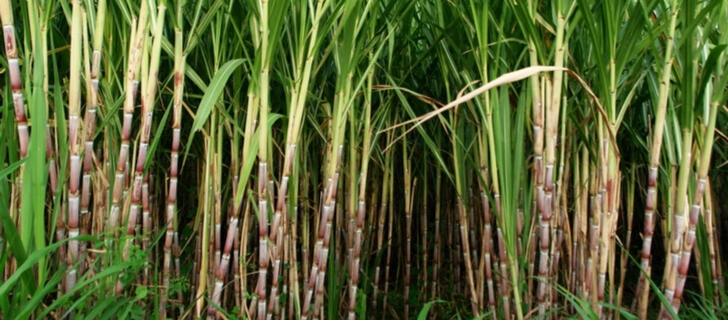
Sugar Cane Growing Conditions
Is sugar cane easy to grow? Yes, it is simple to propagate and grow this crop in general. Still, productive cultivation demands optimum growing conditions for sugar cane. The plant needs a high level of solar radiation and heat to flourish. Active hydration is another requirement for sugar cane growing. Last but not least, the soil should have good aeration, drainage, and a pH level ranging from 5 to 8.5. Each of these growing conditions requires more detailed consideration.
Temperature And Sunlight
For most of its life cycle, the optimum growing temperature for sugar cane is around 32°C (90°F). After the plant grows mature, slightly lower temperatures help to increase the amount of sugar in it. Frost is prohibited for the crop, regardless of plant growth stages. Furthermore, sugar cane needs a lot of sunlight; if plants grow in a shaded field, even at the right temperature, they will suffer.
Since temperature is a critical factor in growing sugar cane, choosing a field with a favorable temperature regime is necessary. EOSDA Crop Monitoring provides historical data on daily temperatures and a sum of active temperatures, allowing farmers to easily assess the potential of a single field or the region as a whole to grow a plentiful harvest. Understanding a field’s microclimate and history of temperature fluctuations gives the ability to quickly determine whether this area is suitable for growing sugar cane. After selecting the field, you can use temperature graphs to follow the trends and plan the growing period to make the most of the local weather conditions.


Water And Humidity
Keeping an optimal soil moisture level is just as important as light and warmth to grow healthy crops and obtain a high yield. During the growing season, the water requirement for sugar cane cultivation is 1500-2500 mm of rainfall (on average 25-50 mm per week). The preferred relative humidity on sugar cane growth is at least 50%. Farmers should not expect high yields if there is a lack of moisture since:
- the plant begins to dry out;
- the crop is growing slower;
- the sugar level decreases.
As a result, if there isn’t enough rain in your area to grow crops, you’ll have to maintain the irrigation system.
At the same time, excessive moisture interferes with plants’ ability to grow, resulting in lower sugar levels, fungal diseases, and rot. Sugar cane should therefore be watered regularly and have well-drained soil during heavy rains.
It is preferable to choose a field with sufficient moisture right away to avoid spending extra money on irrigation in the future. Historical precipitation data on the EOSDA Crop Monitoring platform will be beneficial in selecting the appropriate field for growing the crop. You can easily understand the precipitation trend on a separate field using data from the daily and accumulated precipitation graphs. This information helps to estimate and plan irrigation works required when natural precipitation alone can not suffice to meet the needs of growing sugar cane.

In terms of daily monitoring, the index map based on NDMI and soil moisture graphs will enable the dynamic assessment of water needs and the timely adjustment of current irrigation procedures.

Soil And Nutrients
When it comes to the soil for sugar cane cultivation, the first requirement is good drainage. The best soil for growing sugar cane is one-meter-deep moist, not waterlogged, soil. To grow sugar cane, the ground must be well aerated, which means that after a heavy rain, its pores are filled with air by more than 10% .
It doesn’t require a specific soil type to grow well. Any soil with good aeration, drainage, and fertilizing is suitable.
The optimum soil acidity for growing the crop is 6-6.5 pH. You can still grow sugar cane in more acidic soils, but it might produce less sugar. Additionally, the growing plant is extremely sensitive to salt. Soil salinity causes water stress symptoms, such as wilting, leaf burn, slowed growth, and can even lead to plant death.
Because sugar cane can absorb nutrients instantly, it needs a lot of organic matter to grow. The plant requires much nitrogen and potassium, and less phosphate. But during the ripening period, the soil’s nitrogen content should be as low as possible, stimulating better sugar production.
EOSDA Crop Monitoring
Access high-resolution satellite images to ensure effective fields management!
Propagating Sugar Cane
You can propagate sugar cane in two ways:
- from seeds;
- from cuttings.
Although growing sugar cane from seed is possible, there are better options for commercial cultivation. You’ll need to follow the instructions on the seed package to have sprouts ready to plant in 2-3 weeks.
To grow sugar cane from cuttings, choose a disease-free mature stock. At least six growth points — circles around the stem — must be cut. It is also worthwhile to remove the top of the stem. This cutting is ready to be planted into the ground. It makes no difference whether you place cuttings vertically or horizontally, because sugar cane grows in either orientation. Sprouts should appear one to three weeks after planting in the soil.
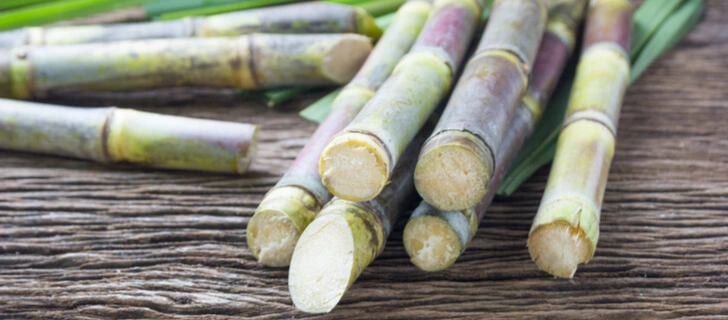
How To Plant Sugar Cane
Sugar cane planting differs from techniques used for other crops. The general planting scheme entails cutting the stem into pieces, land preparation for planting sugar cane, placing the cuttings in the prepared furrows or beds, and covering them with soil.
Overall, the best time to plant sugar cane is late summer and early fall, especially in regions with cool winters.
Sugar cane planting techniques are classified as flat, furrow, or trench. There is no best way to plant sugar cane; each method is appropriate for specific conditions.
Flat Planting
It is a traditional method that includes the following stages:
- opening shallow furrows 8-10 centimeters deep at a distance of 75-90 centimeters;
- planting one-eyed (rarely two-eyed) cuttings in these furrows, with at least one piece every 30 centimeters;
- filling the furrows with 5-7 centimeters of the soil and leveling the field by tillage.
Planting sugar cane with the flat method should only be used when the field has enough moisture. This method is no longer widely used because only 40-50% of cuttings fully grow with it. Even so, in most parts of northern India, the crop is still planted this way.
Furrow Planting
This method is commonly used to grow sugar cane in areas with moderate rainfall but poor drainage. The main steps of furrow planting include:
- making furrows 10 to 20 centimeters deep, depending on the type of soil in the region;
- planting setts in an end-to-end system;
- covering setts with 5-6 centimeters of ground, leaving the upper portion of furrows unfilled;
- incorporating setts into the furrows.
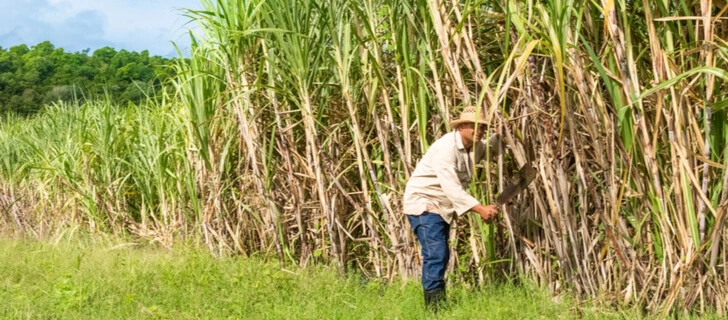
Trench Planting
The trench method of sugar cane planting is one of the most efficient modern plantation methods. It uses fewer two-eyed cuttings per acre and nearly 80% of cuttings sprout and grow mature. Also, the trench method works well to keep plants from lodging in regions with strong winds and where the crop grows very tall.
The major phases of trench planting are as follows:
- digging trenches 20-25 centimeters deep, using a ridger or by hand, every 75-90 centimeters;
- spreading the NPK fertilizer evenly in the trenches and thoroughly mixing it into the soil;
- planting setts from end to end;
- spraying pest control solution on planted setts;
- filling trenches with loose soil.
How To Maintain Sugar Cane
The main farm work begins after planting sugar cane in the soil. Fertilizing, pest and weed management, disease prevention and treatment — you must monitor the need for such activities, plan them in advance, and appoint those in charge of carrying them out.
The EOSDA Crop Monitoring platform includes a Field Activity Log tool to help you easily manage all agrotechnical processes in one place. You can add one-day and multi-day activities to the interactive calendar, track their progress, plan and compare the costs of various operations, and much more. Let us look more closely at the care measures required for growing sugar cane and how satellite technology contributes to their optimal performance.
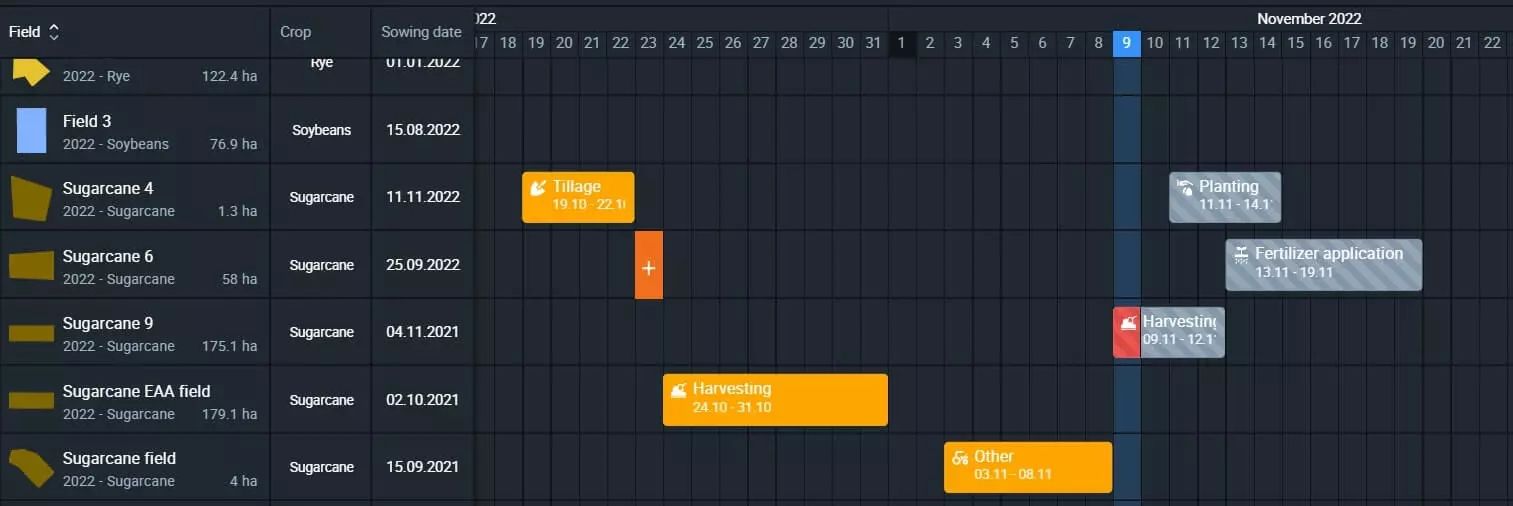
Weeds Identification
Weeds attack sugar cane right after it has been planted in the ground and can suffocate young shoots before they even have a chance to grow. Therefore, integrated weed management is critical during the early stages of the plant development. Fortunately for farmers, crops, as they grow tall, can defend themselves against weeds by blocking their access to sunlight. However, while the plants grow, it is necessary to monitor the condition of the fields and eradicate weeds as soon as possible.
EOSDA Crop Monitoring is equipped with a modified soil-adjusted vegetation index (MSAVI) to observe the sugar cane crop during its early stages of growing. Farmers can use MSAVI to track the level of vegetation and identify potentially problematic areas with uneven sprouting. If values of MSAVI on your field are outside the norm at the early stages of plant development, this could indicate a problem, such as weeds that suppress the growth of the cash crop, affecting the overall yield of the season.
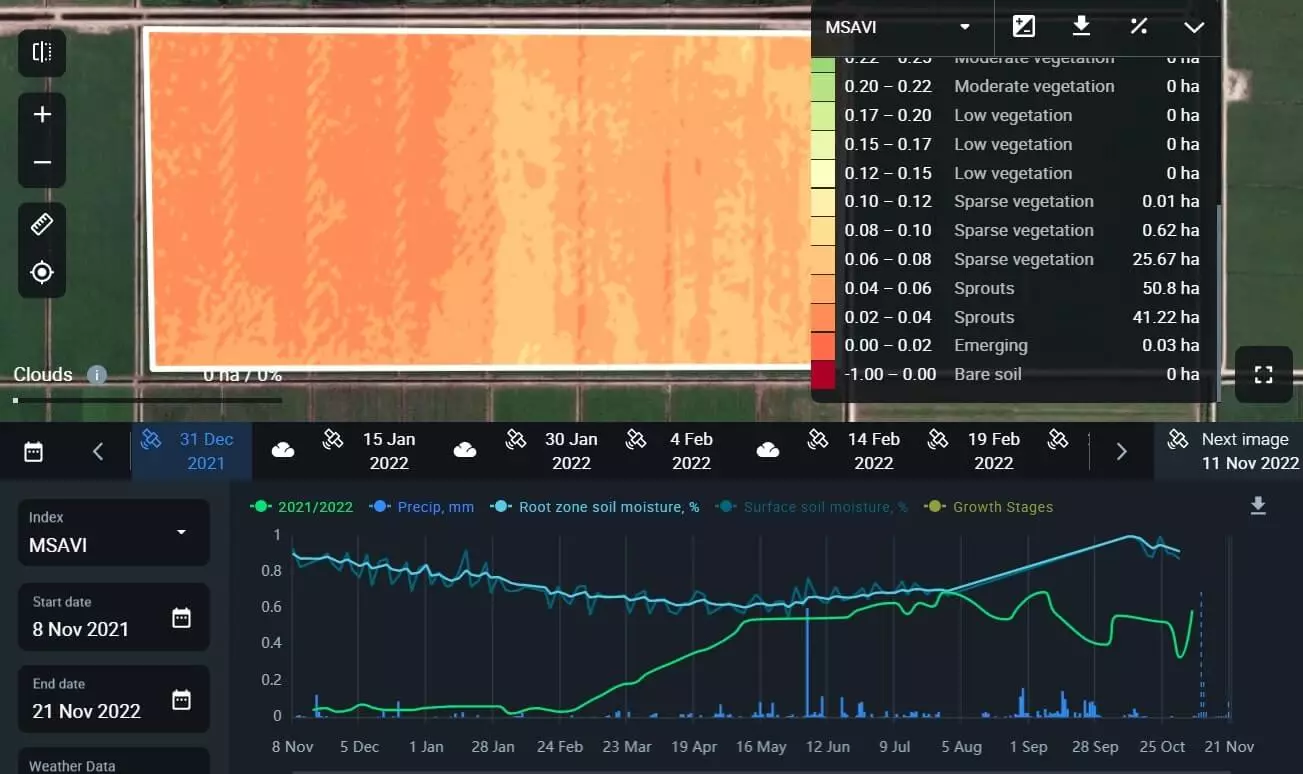
Fertilization
To grow healthy sugar cane plants, you will need to provide constant access to nitrogen, potassium, sulfur, and, to a lesser extent, phosphorus and zinc. Requirements for various elements change as the crop grows. Thus, you should accurately calculate the amount and periodicity of fertilizing depending on the stage of plant growth and the quantity of the element in the soil.
Having said that, precision is indispensable in the fertilization of growing sugar cane. Additionally, different field areas typically require distinctive fertilizing, which can be accomplished using the variable rate application (VRA) method. EOSDA Crop Monitoring includes a zoning feature that allows you to assess the type and exact amount of fertilizer for each part of the field. In the field activity log, you can plan and control all fertilizing activities. Such an approach ensures a balanced distribution (more where it is needed and less where it is not), while being cost-effective and environmentally friendly.

Pest And Disease Management
Sugar cane comes in various types, each with its own pests. The most harmful for growing crops are the following pests:
- Sugar cane grubs damage the roots of Saccharum spp. crop. Although they are not afraid of chemicals, they can be eradicated by flooding or disking the field.
- Sugar cane borers infect Diatraea saccharalis. This pest bores tunnels in stems and feeds on sugar cane pulp. It’s the most dangerous pest, causing a 45% decrease in sugar levels in damaged plants compared to healthy ones. You can successfully control the spread of borers with insecticides.
- Wireworms feed on plants’ roots and buds. Insecticides based on phorate can destroy these pests.
Sugar cane diseases are caused by fungi, bacteria, or viruses and vary depending on geography of growing. Farmers must constantly monitor the condition of their sugar cane plantation. EOSDA Crop Monitoring offers a variety of vegetation indices to help control field conditions and respond quickly to any deviations.
But what if you could stay one step ahead of these threats? Early warnings for disease risks on our platform enhance your ability to protect crops. We monitor for 15 of the most prevalent sugar cane diseases, including gumming, pokkah boeng, and sugar cane mosaic. Thanks to the analytics of up-to-14-day meteorological forecasts and actual crop development stages, you can identify fields that may be at particular risk. As a result, you can strategically prioritize your on-site checks and implement control measures, potentially reducing chemical use and improving crop health.
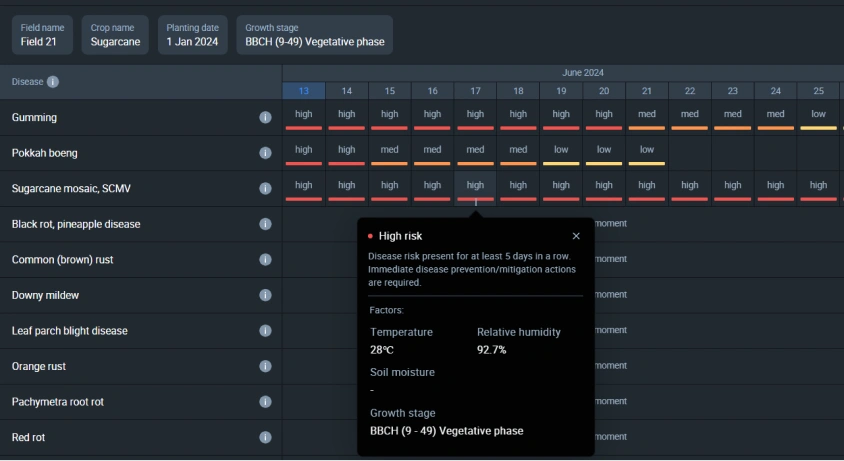
Crop Rotation
Disrupting sugar cane monoculture by crop rotation demonstrated lots of ecological benefits and raised agricultural productivity. A cropping system that includes growing complimentary cultures improves soil health significantly. Crop rotation for sugar cane can include plants with a short or long growing period, depending on the objectives. Sugar cane is typically grown after rice, cotton, maize, wheat, and other crops in two to three years. Intercropping is also popular among farmers who choose to generate more income. Opt for growing onions, potatoes, or coriander alongside sugar cane.
With our remote crop monitoring solutions, you can not only keep track of each field’s crop rotation cycle in one place but also monitor the productivity levels of fields with different crop rotation practices and during different growing seasons. The Productivity Maps tool allows you to evaluate the impact of crop sequence and each crop growing in a specific field. Knowing this, you can select the best crop to grow in this particular field and increase productivity by adjusting the crop rotation. Moreover, productivity maps make it easier to assess the field’s productivity potential for the next growing season.
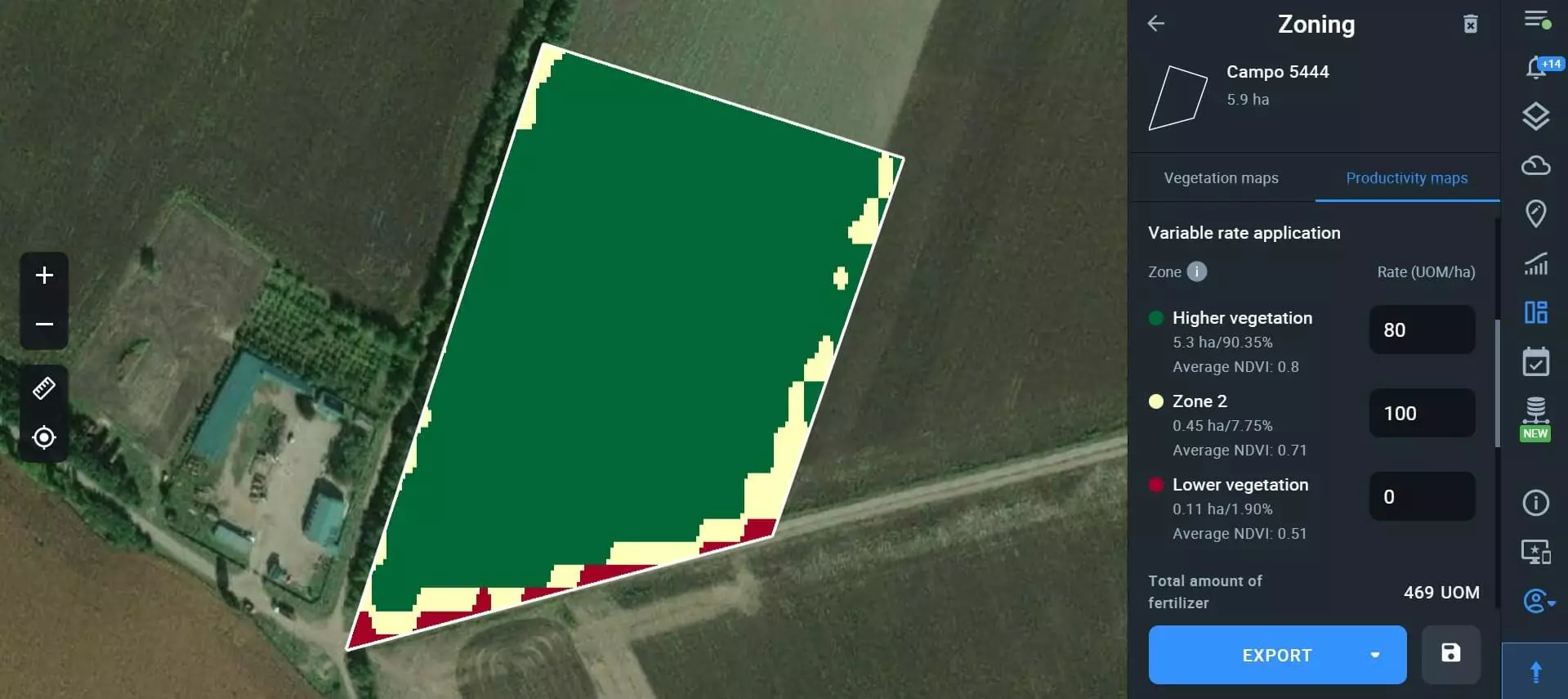

Pruning
When sugar cane is actively growing, it can spread in various directions. In this case, it is preferable to prune a plant, removing excessively branched side shoots and wilted leaves. The crop can technically be pruned at any time. Nevertheless, the later you prune, the more time sugar has to develop in the cane. Cut stems can be reused to grow new plants or mulch the plantation.
Overwintering
Sugar cane should be prepared for winter if grown as a perennial plant in a climate zone with cold winters. After harvesting, cut the stalks as close to the ground as possible. Plant remains should be well covered with cut leaves, straw, or soil to protect the roots from frost. Thus, as soon as it warms up, the crop will grow and produce a harvest again.
How Long Does Sugar Cane Take To Grow?
Although the crop grows quickly, it takes months to mature. The entire sugar cane growing season takes from 9-16 months in warm climates to 18-24 months in cooler climates. The sugar cane growth cycle includes four stages:
- The establishment stage, during which the plant germinates and emerges. This phase lasts between 10 and 30 days.
- Vegetation, when bushing and stem elongation occur. It could take between 150 and 350 days.
- Yield formation, also known as grand growth, lasts 70-200 days.
- The ripening stage duration ranges from 50 to 70 days.
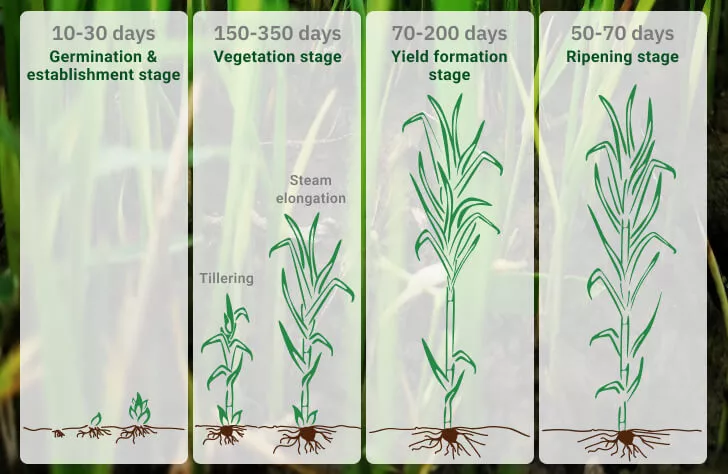
How To Harvest Sugar Cane
Sugar cane is typically harvested in late fall when the plants are tall and mature. You should have enough time before the first frost; otherwise, the sugar content of the stalks may decrease significantly.
The NDRE index in EOSDA Crop Monitoring indicates when the crop is ready to be harvested. Instead of scouting all the fields in the area and manually checking them, use this index to predict harvest time and plan further operations in the field activity log. It is a massive help in optimizing resources in sugar cane growing.
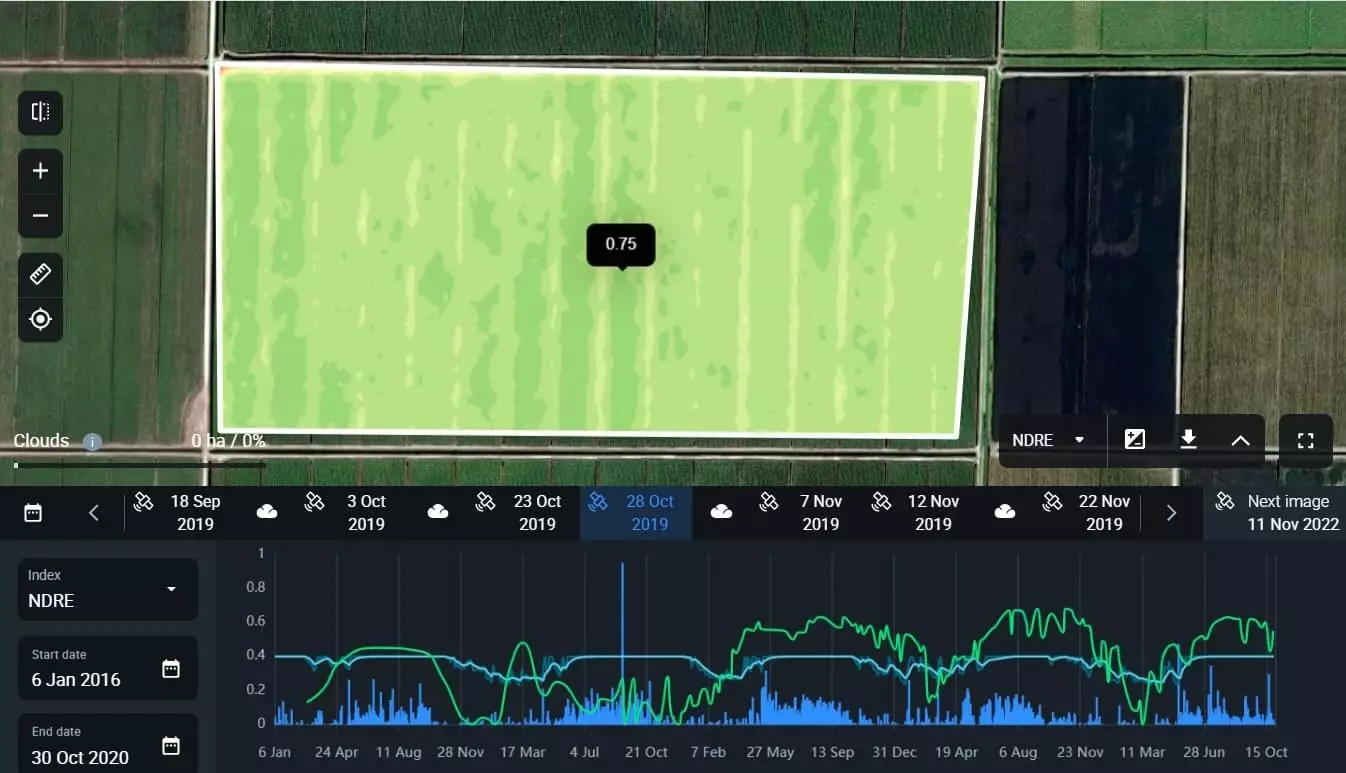
In tropical regions, after harvesting, the roots are left in the ground because one plant can grow and produce a harvest during 3-5 years. Following the stem cutting, new sprouts — ratoons will grow on the stump. It is worth mentioning that these ratoons produce less sugar than the parent plant.
Still, in some areas, crops are harvested in an old-fashioned way: farmworkers burn the excess leaves and then cut the stems with a machete. This method is too labor-intensive and has negative environmental consequences due to the burning of plantations. Modern machines that cut stalks slightly above ground level as they pass between rows of plants have significant benefits for sugar cane growers and the overall ecosystem.
Tailored Solutions For Growing Sugar Cane
Sugar cane growing is one of agriculture’s strategic areas. So farmers should have up-to-date and accurate data on the location and condition of crops growing in their fields to make wise land and crop management decisions, improve logistics, and contribute to food security. Primarily serving these purposes, EOSDA has developed custom solutions for sugar cane growers:
- Crop classification: a complex solution for building and revision of the actual crop map based on neural network analysis of satellite images from multiple sources. This EOSDA solution has an accuracy of 94% in detecting sugar cane mills, which cannot be achieved with standard satellite image segmentation methods.
- Harvest dynamics monitoring determines the status of harvesting on a particular field on a specific day with high accuracy (around 93%) for improved planning and yield assessment. This solution will be especially beneficial to large sugar cane producers.
Get in touch with our sales team at sales@eosda.com to learn more about EOSDA Crop Monitoring applications and custom solutions for more intelligent and productive sugar cane growing.
About the author:
Vasyl Cherlinka is a Doctor of Biosciences specializing in pedology (soil science), with 30 years of experience in the field. He attended the engineering college in Ukraine and received his degree in agrochemistry, agronomy and soil science in the Chernivtsi National University. Since 2018, Dr. Cherlinka has been advising EOSDA on problems in soil science, agronomy, and agrochemistry.
Recent articles

Analyze 2025 & Plan Your Best Year Yet: LandViewer Christmas Offer
It’s the most wonderful time of the year! The Christmas holidays are here, and so is your chance to analyze 2025 and plan a prosperous 2026 with more affordable Pro plans in LandViewer.

EOSDA Models Climate Change Impact On Sugarcane Yields
EOSDA modeled future temperature, rainfall, and other climate impacts on Veracruz sugarcane. The results help growers plan long-term adaptation strategies, including timing, varieties, and irrigation.

EOSDA LandViewer Black Friday Sale: Exclusive Offers & Giveaway
This Black Friday, LandViewer offers new users the chance to save on monthly plans, get extra months with yearly subscriptions, and participate in a free annual plan giveaway.